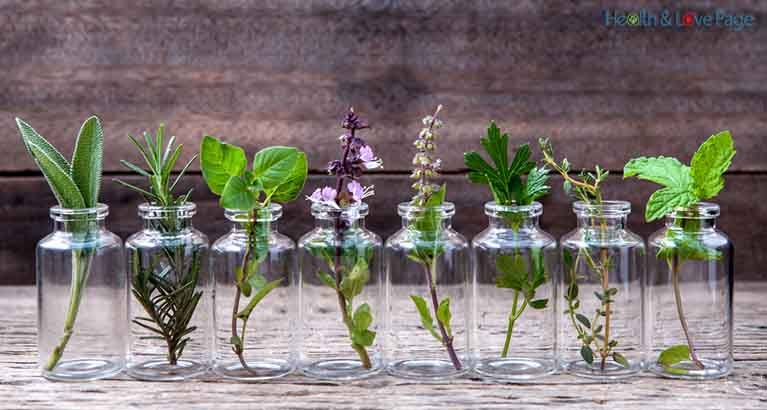The herbs provide many health benefits to your body due to their medicinal, culinary and relaxation properties. However, they are not always available in a raw state throughout the year. So, why don’t you grow some of them in your kitchen? In this way, you will not only keep them close at hand but they will provide a pleasant flavor in your kitchen.
The following method of growth doesn’t include regular watering, soil or changing seasons. What you only have to do is place a certain herb in a water and let it grow. Don’t worry, these herbs are as flavorsome as those you grow in the garden.


How to Grow Herbs in Water
Water
You can place some herb cuttings in glass bottles full with plain water in order to keep them at hand. Avoid chlorinated water, because the bleaching chemical can damage the plant tissues. Instead, leave some tap water to air overnight or store some rainwater. The best solution is spring water because of the amount of minerals it contains.Containers
As a container choose some mason jar, glass bottle or even plastic bottle. Roots doesn’t like to be exposed to light so use some colored bottles especially those with amber color or you can eve wrap a piece of paper around the bottle in order to create a dark space. The dark zone will prevent algal growth on the bottle and on the root. This will not affect the plant growth but will make the bottles look untidy. The narrow-mouthed containers can support the cuttings and keep them upright but it should not be narrow or tight-fitting because the mouth of the container should allow free transition of air in order the roots to breathe.Plant cuttings
Soft cuttings root quickly in water without using any rooting hormones. So, cut some 6-inch sections from the growing herbs and place them in the water-containers. Remove the lower leaves from the cuttings because there shouldn’t be any leaves in the water. They can rot very easily thus spoiling the water as in the flower vases. Some herbs as the rosemary cuttings may take longer to root. In that case, change the water once a week but be careful not to disturb the cuttings. When the roots start growing, often between 2-6 weeks, the water changes may not be necessary. If you want to encourage rooting, take some willow branches and place them in warm water overnight. They will provide a rooting hormone mix. Also, you can use some rooting hormone powder.10 Herbs You Can Grow in Water
1. Peppermint – This popular mint is well-known for its medicinal properties as well as the high amount of the volatile substance menthol. Menthol gives a cooling sensation on the skin or tongue without causing any variation in the temperature. This is one of the easiest herbs to be grown in water, just place some fresh peppermint cuttings in water. 2. Spearmint – Another type of mint that is closely connected to peppermint. In fact, peppermint is a natural hybrid of spearmint. 3. Basil – is the ideal herb that would grow in a water-filled container and in a warm indoor place. You only have to provide the basil a good light. Place the basil cuttings in water before they start flowering. This water growing method is a perfect if you want to preserve some varieties of basil during winter. 4. Oregano – The leaves of this herbs are used almost with any vegetable. So, take fresh cuttings of oregano and place them in water. Pinch the growing tips as the plant grows well. 5. Stevia – It is good to have this type of herb in your home in order to add it to some beverages and teas. Take some stevia cuttings from actively growing branches and put them in water. Place the container in a warm place with as much light as possible. 6. Sage – Take some cuttings of this herb in the spring and put them in water. You don’t need more than 2 plants because you will need very tiny amounts for flavor. The herb need a bright light and a well-aerated place because it is prone to mildew. 7. Tarragon – Take some cuttings in the spring after new growth appears. The fall ones are good also but it will take time until the roots grow. It also needs warm place and bright light. There are certain varieties of tarragon, the French one is best for culinary purposes while the Russian one is bland so it is more appropriate for salads. 8. Lemon balm – The lemon flavor is a pleasant scent in every home, especially during the winter. Take some cuttings in spring or fall. You need to provide a warm place with bright but indirect light for the lemon balm. It may take 3-4 weeks until the cuttings develop roots. Regularly change the water if the plant is inside or you can keep it outside while the weather is still warm. While outside you can avoid the mildew that the lemon balm experiences. Bring the cuttings indoor when they are well established. You can use the leaves for making tea. 9. Rosemary – It takes longer to root the semi-woody cuttings of rosemary but if you take some new shoots in the spring, they may grow faster. This is an excellent indoor plant that should be kept on a sunny spot. 10. Thyme – You need new grown cuttings that are green in color. The old one is brown and stiff so that it can take a longer time to root. So, choose some in the mid-spring or early summer before it starts flowering. Put the cuttings in water immediately because they can dry out very fast. Even spray the part which is above the water. When it grows, cut the stems to improve branching. Via Natural Living Ideas
Leave a Comment
